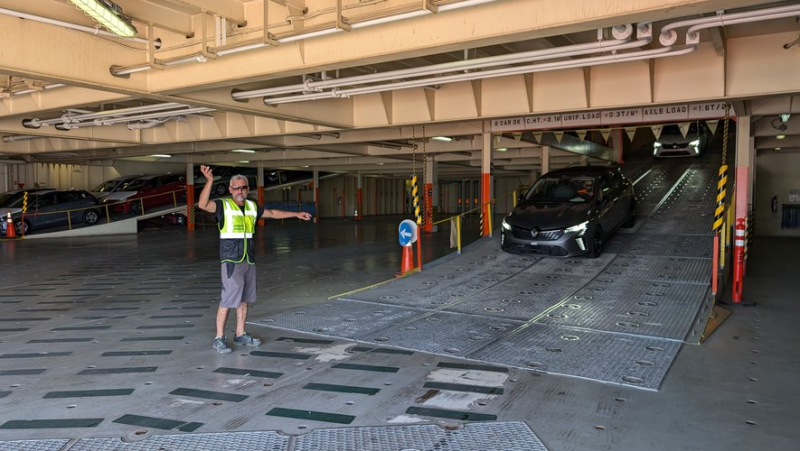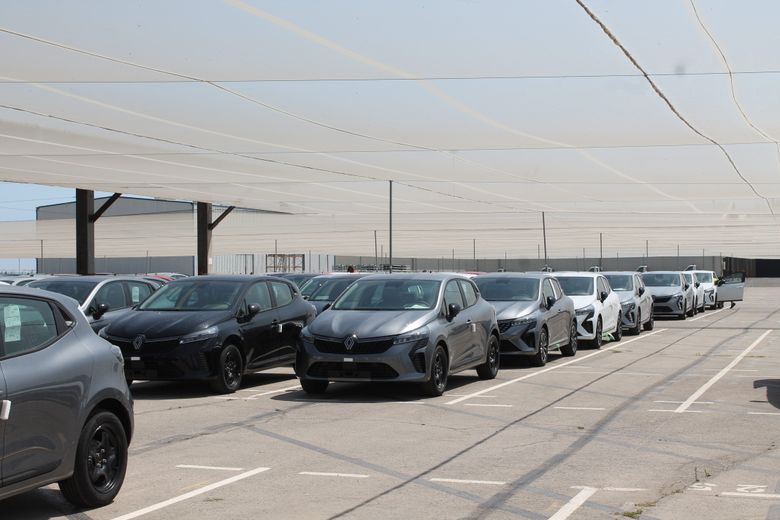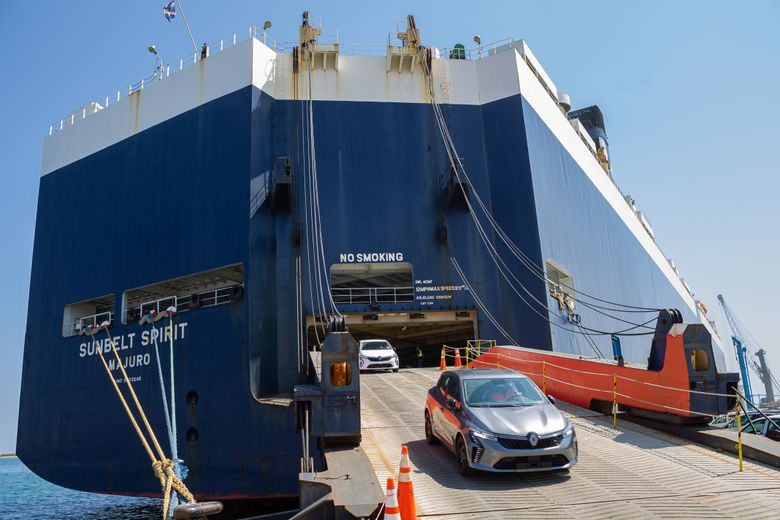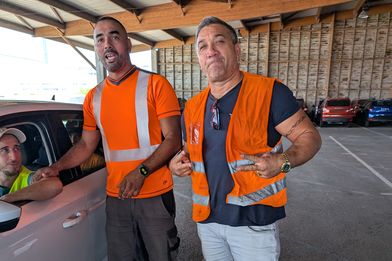They will unload 140,000 vehicles in 2024: the booming activity of dockers at the port of Sète

Jean-Michel Calueba, placeur bord, aide les jockeys à sortir du navire les voitures en toute sécurité. MIDI LIBRE – KELMAN MARTI
As you pass the Zifmar car park, you may have wondered how the cars arrive. Today, we explain everything to you.
This Monday, 1 p.m. In Sète, locals and tourists are having a meal. On the other side of town, at the port, it's the start of the day for a number of dockers. 27 of them are on duty until 8 p.m., and from 6 a.m. to 1 p.m. Tuesday, to unload 2,135 of the more than 4,000 cars brought in by the Sunbelt Spirit.
Shuttlemen and jockeys
“A hell of a job” for the day's employees. Without losing a single minute, here are five shuttles, two vans and three cars, rushing respectively towards decks 6, and 12 and 13 of the ship.
“You should know that dockers are constantly changing jobs and today, I am a shipper”, launch Nicolas Calzada, comfortably seated in the car with which he “will drive in circles for a duration equivalent to a Sète – Paris". “My role is to safely and quickly take the jockeys (those who unload the cars, editor's note) into the boat”, he adds, as he reaches the upper deck in precisely 1’40 from a parking lot at the port.
The job is quite dangerous because of the risk of crossing paths
His colleagues get out. They take the wheel of the Renault Clios filling the immense bridge where the mercury easily exceeds 40 °C. He maneuvers skillfully, before returning to the parking lot of quay H.

The port has nearly 30 hectares of parking for cars. MIDI LIBRE – KELMAN MARTI
“Now, we're going to take the cars down, one after the other, and then park them”, continues Gino Toso, a young 21-year-old jockey, already an ace pilot.
An activity that has the wind in its sails
Before 2007, the port of Sète was not used for the transit of vehicles to Europe. But that year, the Syntax group (now CAT) arrived with a contract for 12,000 cars.
“At first, few people believed in the development of this activity, remembers Jean-Michel Calueba. There were fewer dockers and they took longer to unload, while there were fewer ships. Then, mentalities changed. We improved. We started to get better performance and so we could take care of more boats. That led to a lot of hiring and the expansion of the storage parking lots."
In 2024, signs of the development of this port activity, 140,000 vehicles are expected to pass through Sète, almost 12 times more than 17 years ago, and the creation of Zifmar 2, of an additional 15 ha, was approved in April.
The important role of the on-board marshal
During the descent to the quay, at each ramp between the different bridges, he is honked and receives flashes of his headlights. Nothing more normal: the shuttles that are going up signal their presence. “The work is quite dangerous because of the risk of crossing between vehicles that do not always have good visibility”, notes Sahin Onur, head of handling, scrutinizing with a keen eye that everything is going well.
At his side at the entrance to the ship, Jean-Michel Calueba, on-board usher. His mission: to avoid accidents. With his hands and like a traffic officer, he orders, for example, cars to stop to let out those that are going to the parking lot. “I also make sure to keep traffic flowing and help the jockeys with their maneuvers”, the experienced docker explains.
A very precise unloading plan
Didier Garcia, foreman, passes by furtively, navigating between the different decks of the 212 m long and 32 m wide building. If the operation is going so well, it is partly thanks to him. In the morning, “in 5 – 10 minutes", it "determines the unloading plan of the vehicles to be as efficient as possible".
“Generally, we know the boats, we know that we have to start with the upper deck to guarantee stability and how to distribute the shuttles. Before starting, we still have a check with the ship's crew to see if it suits them”, specifies Didier Garcia.
By the time these explanations are given, the jockeys and shipmen have already had time to empty the decks. Their work is measured to the millimeter. It only takes Gino Toso 1’40 again to go from the 13th floor to the parking lot.
We place the cars from right to left and sort by model

The jockeys leaving the ship follow the shuttle driver towards the parking lot where the cars are parked. MIDI LIBRE – KELMAN MARTI
As soon as he arrived, he immediately parked, in forward gear, in the space indicated to him by the land marshal. This Monday, it was John Ragno who wore this cap. “We place the cars from right to left and start at the back. At the same time, we sort by model so that we have the Clios on one side, the Dacias on the other. Then, once the parking lot is full, we change”, he explains, before cracking a joke to his shipyard and jockey colleagues, who are in for yet another round trip under the blazing sun. Because being a docker isn't just working at the port, it's also being part of a family that lives in a good mood.

At the port, the atmosphere is family-oriented, but remains professional. MIDI LIBRE – KELMAN MARTI
What happens to the vehicles after arriving in Sète ?
When Renault, Dacia and other Fords arrive by ship in Sète, the dockers park them in the car parks depending on the transport and logistics company that will take care of them.
There are two of them: CAT (formerly Syntax), which has been working with the port since 2007 and takes care of 90,000 vehicles each year, and Groupe Charles André (GCA), which arrived in May and takes care of 50,000 per year. The employees of these companies then prepare the cars directly from the port: visual inspection, repair and installation of options if necessary, washing (interior, exterior, windows), hand wiping, mechanical inspection and finally quality control. Then, they are transported by heavy goods vehicles to the car dealerships.
In other cases, often on Mondays, dockers load some of the vehicles onto freight trains. Towards Paris, then to dealerships in the north of France.
I subscribe to read the rest




